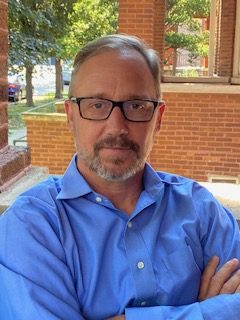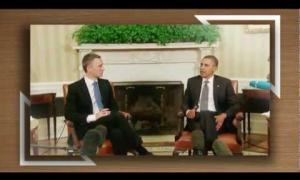Book Review: Confessions of a Presidential Speechwriter
March 05, 2014
Craig Smith wrote speeches for Presidents Ford and George H.W. Bush, and Lee Iacocca. Now he's written a book about the experience
…[O]nce you’re launched [as a speechwriter], it’s just like theater or being published, being in a decent production or having a good publisher. After you’ve had a book or two out then things take care of themselves a great deal more than when you’re on the outside trying to get in. —Excerpt from 2005 interview with White House speechwriter Aram Bakshian, Jr.
The above observation about the career momentum of speechwriters came to mind while reading Dr. Craig Smith’s excellent new book Confessions of a Presidential Speechwriter (Michigan State University Press, 2014). Confessions is Dr. Smith’s 16th book and traces the course of his life not only as a presidential speechwriter, but as an academic, an aide to Senator Robert Packwood (R-OR), a researcher and consultant for CBS News, a political campaign manager, a free speech/First Amendment advocate—and as a man coming to terms with his sexual orientation. This is more than just a speechwriting story—it is a very human story.
Now a full-time faculty member with California State University, Long Beach’s Communications Studies Department, Dr. Smith’s entrée into speechwriting occurred during the Ford Administration. One of his first major speechwriting productions (to adopt Bakshian’s term) involved a series of speeches that President Ford delivered to mark the Declaration of Independence’s 200th birthday. Ford’s remarks at Valley Forge (which Smith worked on extensively) are highlighted in the book.
In a telephone interview, Dr. Smith told me that, looking back, his work for CBS turned out to be good preparation for the White House. If you can learn to jump into action when you hear the words “Walter Cronkite needs this question answered,” you can also learn to write quickly enough so that the President isn’t kept waiting for a speech.
“One of the reasons I was so successful as a speechwriter with President Ford,” Dr. Smith said, “was that I brought to the job all the tools that one gains with a background in communications studies, such as formal study of Aristotle’s writings on rhetoric. I was the first White House speechwriter to have this background. This training gave me a much richer set of tools” than those who, for example, come into speechwriting via journalism, he observed.
“President Ford told me that he wanted to speak to the common man through his speeches. With my training, I knew how one could address the common man, while at the same time delivering an interesting speech. My graduate studies included extensive analysis of tropes and figures of speech. These are the stylistic touches that often help us remember particular lines in speeches, such as FDR’s ‘the only thing we have to fear is fear itself,’ thanks to their rhythm, pattern and form,” Dr. Smith said.
Balancing these formal credentials is Dr. Smith’s extensive practical experience as a debater during high school and his undergraduate years—which trained him to think on his feet and write quickly. Debate also helped Dr. Smith appreciate the power of coupling the right evidence with the right argument to achieve influence with an audience.
With this initial White House experience, Dr. Smith embarked on a odyssey that has seen him provide everyone from George H.W. Bush (“a sensitive man, a compassionate man”) and Governor Pete Wilson (R-CA) to Condoleezza Rice, Senator John Chafee (R-RI), Senator John Heinz (R-PA) and auto executive Lee Iacocca with advice on speeches.
“Speeches really can change history. If you know what you’re doing, they can really make a difference,” Dr. Smith said. As an example, he pointed to the impact of George H.W. Bush’s speech while accepting the Republican Party’s presidential nomination in 1988 on the candidate’s fortunes—Bush went from lagging behind Michael Dukakis, the Democratic Party hopeful, to leading in the polls. Smith helped write that speech, which contains both the famous “thousand points of lights” reference and the infamous “read-my-lips-no-new-taxes” declaration (not Smith’s doing) as well.
In one important section of this book, Dr. Smith presents a checklist one might follow when writing a speech. These include: determining the arguments one will make and the most suitable order in which to make them; incorporating the best available evidence to support these arguments; identifying the desired emotional interplay between audience and speaker; and bringing unity to the various stylistic touches that give a well-argued speech its final polish.
And there’s also the matter of rehearsal, since “a great speech can be ruined by poor delivery.”
“Lee Iacocca knew the importance of rehearsal, but George H.W. Bush felt it to be a bit unmanly,” Dr. Smith recalled. “When writing speeches for clients these days, I bring the speech and first read it out loud to them, so the client can hear the rhythm and so on. I tell them, ‘this is what the speech is going to sound like.’ This works out much better than just handing them a copy to read,” he said.
Dr. Smith refers several times in Confessions to how elected officials have long turned to pollsters and survey data to help select the themes of major speeches. In response to a question about the possible pitfalls of over-reliance on polling when planning a speech, he shared the following:
“Aristotle tells us that you must know your audience—that’s the most important first step in preparing a speech. The more you know, the more you can adapt the speech to them. But you can’t use polling data to tell an audience ‘here’s what you want to hear.’”
“So you cannot just write a speech to the polling data. A strong speech needs to appeal to the emotions, the mind and the spirit. When selecting evidence, for example, you need to rely on sources to which your audience will respond with openness and interest. And a very strong speech aims to persuade the audience three times. You’ll see this dynamic at work in speeches from Mark Anthony’s address to the Romans in Shakespeare’s Julius Caesar to Jesse Jackson’s ‘Quilt’ speech at the 1988 Democratic National Convention,” he added.
My one quibble with this memoir was that, given his unique perspective as both learned theorist and expert speechwriter, Dr. Smith did not write even more extensively about the meshing of communications theory with speechwriting practice. Readers who enjoy the speechwriting checklist described above that appears in Dr. Smith’s Confessions may also wish to read his Rhetoric and Human Consciousness, which explores rhetorical theory in much more detail.




